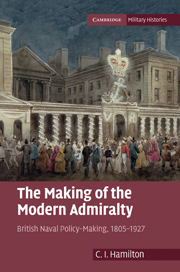Book contents
- Frontmatter
- Contents
- List of tables
- Preface
- Introduction
- 1 Lord Barham's Admiralty: 1805
- 2 Admiralty reform, 1806–1835
- 3 Decision-making at the Admiralty, c. 1806–1830
- 4 Admiralty administration and decision-making, c. 1830–1868. The Graham Admiralty
- 5 The Admiralty reformed again: context and problems, 1868–1885
- 6 Administrative and policy-making responses, c. 1882 onwards
- 7 Fisher and Churchill, and their successors, 1902–1917
- 8 The Naval Staff, planning and policy
- 9 Lord Beatty's Admiralty
- Conclusion
- Appendix 1 First Lords, First Sea Lords and Permanent Secretaries, 1805–1927
- Appendix 2 Acronyms and definitions
- Manuscript sources and select bibliography
- Index
6 - Administrative and policy-making responses, c. 1882 onwards
Published online by Cambridge University Press: 03 May 2011
- Frontmatter
- Contents
- List of tables
- Preface
- Introduction
- 1 Lord Barham's Admiralty: 1805
- 2 Admiralty reform, 1806–1835
- 3 Decision-making at the Admiralty, c. 1806–1830
- 4 Admiralty administration and decision-making, c. 1830–1868. The Graham Admiralty
- 5 The Admiralty reformed again: context and problems, 1868–1885
- 6 Administrative and policy-making responses, c. 1882 onwards
- 7 Fisher and Churchill, and their successors, 1902–1917
- 8 The Naval Staff, planning and policy
- 9 Lord Beatty's Admiralty
- Conclusion
- Appendix 1 First Lords, First Sea Lords and Permanent Secretaries, 1805–1927
- Appendix 2 Acronyms and definitions
- Manuscript sources and select bibliography
- Index
Summary
Board, private offices and committees
Slowly, over the nineteenth century, British government planning became less individualistic and more institutionalised, including in defence matters. By at least 1818, as Huskisson told us, problems to be brought before the Cabinet by the First Lord of the Admiralty would first be discussed by him in an ad hoc way with the Prime Minister and the Chancellor of the Exchequer. Such meetings continued, but from the 1850s there was also a formal Cabinet sub-committee on defence, though it did not necessarily meet very often. Its main duty seems to have been to discuss the naval estimates, but it might also have had to deal with some of the growing number of technical defence matters. Even by then, more specialised advisory bodies had appeared, albeit only temporary ones; a later tendency was towards permanency. We have seen already the example of the Colonial Defence Committee (CDC) of 1878–9. Even its supersession by the Carnarvon Commission proved passing; 1885 saw a resurrection, and the CDC became the forerunner of a whole series of permanent interdepartmental or Cabinet defence-planning bodies, including the Committee of Imperial Defence (CID) of 1902. The latter proved to be highly fecund, spawning the committees and sub-committees on which much British war-making was to be based.
We see something of the same kind of development within the Admiralty. But before looking at the new naval standing committees that resulted, we first have to understand what happened with regard to the Board itself.
- Type
- Chapter
- Information
- The Making of the Modern AdmiraltyBritish Naval Policy-Making, 1805–1927, pp. 180 - 212Publisher: Cambridge University PressPrint publication year: 2011

